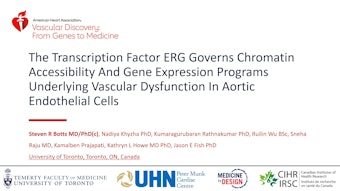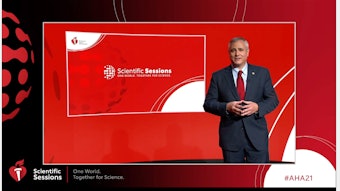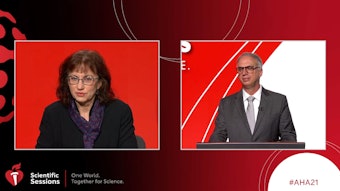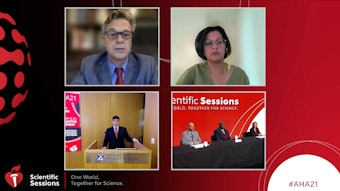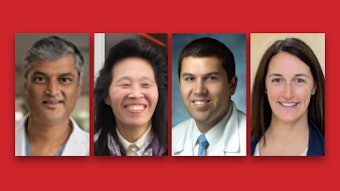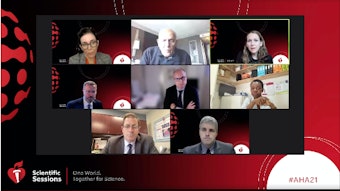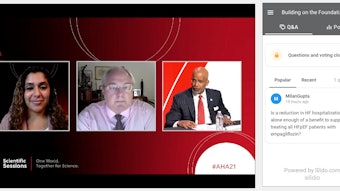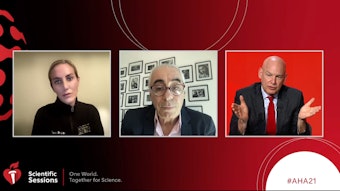Late-breaking science: New information in cardiac disease
Information overload: Striving to improve care delivery through digital health and automated data.
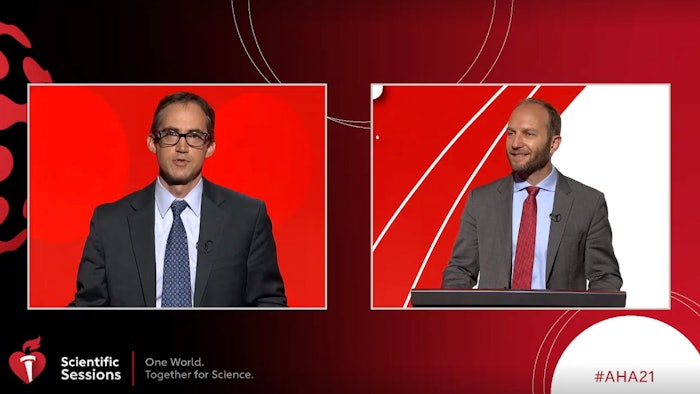
Sunday’s Late-Breaking Science session “Information Overload: Striving to Improve Care Delivery Through Digital Health and Automated Data,” revealed that:
- Clinician knowledge of heart failure (HF) patient risk prognostic information during hospitalization did not significantly improve patient outcomes.
- Wearables may enable large-scale identification of undiagnosed atrial fibrillation (AF).
- Growing body of evidence suggests caffeine does not seem to trigger increased AF, but alcohol does in symptomatic AF patients.
Identifying the role of prognostic information in heart failure treatment decisions
A longstanding assumption in heart failure has been that accurate risk evaluation guides clinical decision-making in selecting therapies most likely to benefit individual patients. The first study to examine this hypothesis using a randomized design, the Risk Evaluation and Its Impact on Clinical Decision Making and Outcomes in Heart Failure: REVeAL-HF trial, found that when clinicians were given knowledge of their patient’s heart failure (HF) prognosis during hospitalization, the additional information did not significantly impact the primary study endpoint of composite of all-cause mortality at one year or re-hospitalization in 30 days.
Guidelines and treatment recommendations for heart failure are largely based on the percentage of left ventricle ejection fraction, said Tariq Ahmad, MD, MPH, director of cardiac transplant and mechanical circulatory support and interim chief of the heart failure program at the Yale School of Medicine and Yale New Haven Health.
“A 20-year-old with a left ventricle ejection fraction of 20% who is otherwise healthy is very different from an 80-year- old with a left ventricle ejection fraction of 20% and multiple comorbidities,” Dr. Ahmad said. “Taking those differences into account is important as we make decisions about medications and invasive therapies.”
Yale researchers designed a risk score to predict one-year mortality among patients hospitalized for heart failure based on multiple historic measures in the Yale New Haven Health electronic health record. Variables included age, weight, systolic blood pressure, red cell distribution width, blood urea nitrogen, monocyte count, lymphocyte percentage, blood urea nitrogen-top-creatinine ratio, troponin, NT-proBNP, mean corpuscular volume, intensive care unit admission and measurement of arterial pH. Based on these patient data in the electronic health record (EHR), the risk score could be calculated immediately.
REVeAL-HF was a pragmatic, embedded trial that randomized 3,124 adults hospitalized for HF to usual care with no alert or an alert for one-year mortality risk assessment. Clinicians caring for patients in the intervention group automatically received their patient’s risk score as an alert at the time they were entering treatment orders. Providers had the option to supply feedback on their impression of the risk score and to adjust orders based on individual patient risk scores.
Dr. Ahmad said, “We need to move toward more risk-based treatment recommendations in heart failure guidelines, which do not currently exist. The benefit from treatment varies significantly across the spectrum of risk, and this information is crucial for shared decision-making. Our study also shows the underutilization of palliative care for patients at high risk for adverse outcomes, a major gap in the current treatment of patients with heart failure.”
Smartwatches, other wearables offer new approach to detect undiagnosed AF
A nationwide trial found that Fitbit fitness trackers or smartwatches can detect atrial fibrillation (AF) and identify undiagnosed users who could benefit from clinical intervention. The Fitbit Heart Study involved 455,699 adults from May through October 2021 who habitually wore a Fitbit-compatible device and did not have a prior AF diagnosis. The study used optical pulse photoplethysmography sensors built into devices to measure pulse waveform data that may be useful to infer the presence of cardiac rhythm abnormalities, such as AF.
The median age of participants was 47 years and 12% were ≥65 years, 71% were female and 23% were non-white, reported Steven A. Lubitz, MD, MPH, FAHA, physician investigator and cardiologist at Massachusetts General Hospital and associate professor of medicine at Harvard Medical School. Pulse photoplethysmography data from participating Fitbit users were analyzed centrally using a novel software algorithm.
Participants with an irregular heart rhythm detection were notified and invited to schedule a telehealth visit with a commercial telehealth provider. The provider screened participants for eligibility and sent eligible individuals an electrocardiogram (ECG) patch monitor to be worn for one week. At the end of the week, the monitor was returned by mail for data evaluation and participants were encouraged to schedule a follow-up telehealth visit to discuss results and potential next steps.
The primary endpoint was the positive predictive value (PPV) of the first irregular heart rhythm detection during ECG monitoring, which was defined as the percentage of participants with an irregular heart rhythm detection with ≥30 seconds of concurrent AF confirmed on the ECG.
A total of 4,728 individuals (1%) over all received an irregular heart rhythm detection notification, of whom 2,070 (4%) were 65 years or older. Among the 1,057 individuals who had an irregular heart rhythm detection notification and analyzable ECG patch monitor data, 32.2% (340 participants) had documented AF present on the monitor. During the one-week ECG monitoring period, 225 individuals had an irregular heart rhythm detection and 221 of those had concurrent AF on the ECG, corresponding to a PPV of 98.2%. The PPV was 97.0% for individuals aged 65 or older participants with irregular heart rhythm detection positive predictive value for concurrent AF on ECG patch.
“The study shows that using wearable devices can enable large scale and accurate identification of individuals with undiagnosed AF,” Dr. Lubitz said. “There is a substantial probability that when the algorithm fires and notifies the user of an irregular heart rhythm, that they will indeed have AF on subsequent confirmatory follow-up testing using an ECG patch monitor.”
Alcohol, but not caffeine, triggers AF
The first study of patient-selected triggers for atrial fibrillation (AF) found that alcohol use was associated with a higher risk of acute symptomatic paroxysmal AF events, but caffeine intake was not. The Individualized Studies of Triggers of Paroxysmal Atrial Fibrillation (I-STOP-AF) study randomized patients with a smartphone 1:1 to undergo individualized (N-of-1) testing of a self-selected trigger versus AF electrocardiogram (ECG) monitoring alone. The N-of-1 test group submitted daily smartphone-based ECG monitoring and self-reported on the effect of either avoiding specific AF triggers or intentional exposure to those same triggers.
The N-of-1 design allowed 251 participants to test individually selected triggers in randomly assigned one-week periods over six weeks. The most common triggers were caffeine, alcohol, exercise and reduced sleep. Less commonly selected triggers included lying on the left side, dehydration, cold food or drink, large meals, specific diets and customized triggers. Trigger compliance was assessed with daily questionnaires and the frequency of AF was determined by real-time self-report through the mobile app and remote ECG.
After six weeks of trigger testing, participants were given the results of their tests and given four weeks to modify their behaviors and lifestyle in response to their individual test results, during which time they were followed for an additional four weeks with daily AF and ECG reporting.
A control group of 248 participants who did not test for triggers were asked about AF events the prior day and submitted a remote ECG each day for 10 weeks.
Of 446 participants who began the study, 320 (72%) completed all study activities.
The primary outcome was the change in Atrial Fibrillation Effect on Quality-of-life (AFEQT) score at 10 weeks and secondary outcomes included the number of daily AF events recorded during the four weeks following trigger testing.
There was no difference in AFEQT scores between the N-of-1 and the AF monitoring only groups, reported Gregory Marcus, MD, FAHA, professor of medicine at the University of California, San Francisco. Although testing had no effect on overall quality of life scores, the N-of-1 group had significantly fewer AF events during the four weeks after testing, adjusted RR=0.60, p<0.0001. Participant-reported data showed consumption of alcohol, but not caffeine, was associated with AF events.
“To my knowledge, this is the only randomized trial to assess the relationship between caffeine exposure and AF,” Dr. Marcus said. “It contributes to the growing body of evidence that caffeine does not seem to increase the risks for AF and that alcohol does contribute to AF risk in a very acute sense.”


